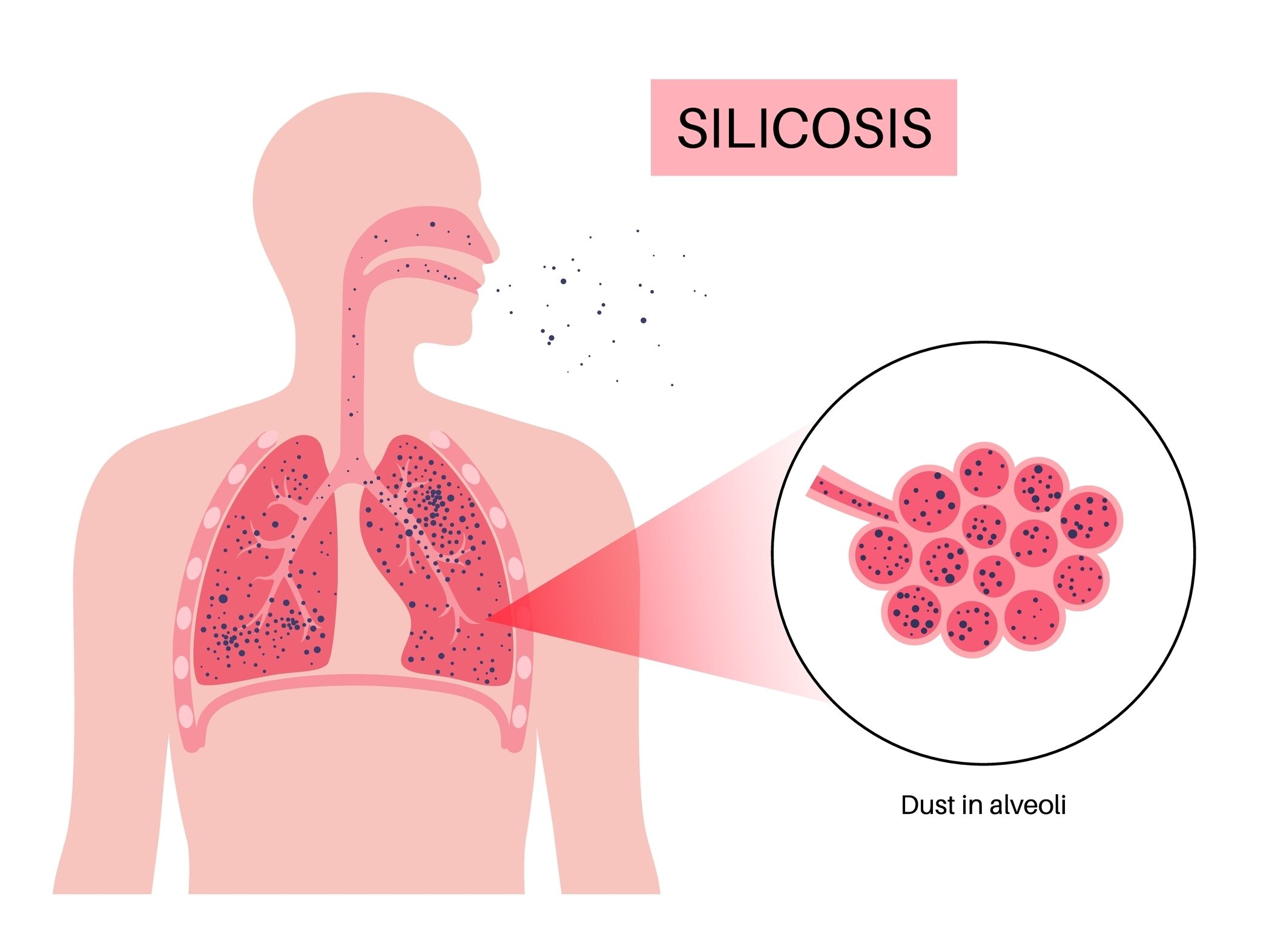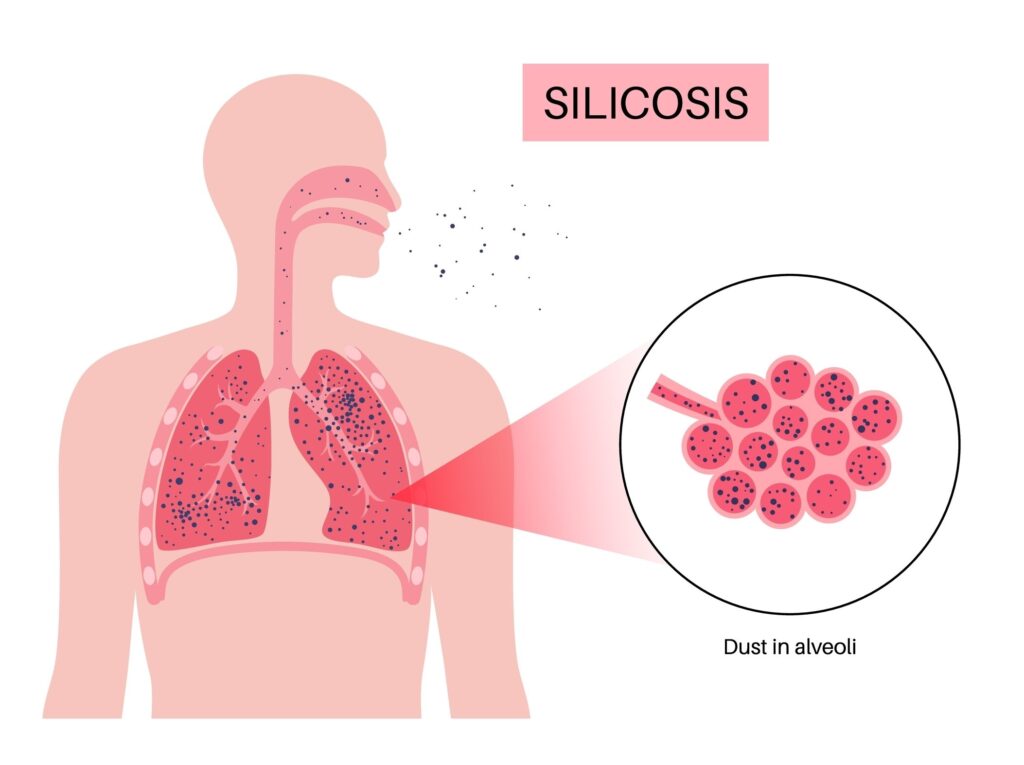
Do you have Silicosis?
Silicosis is a lung disease that may be caused by stone dust. You may be entitled to compensation!
Call NOW for a Free, Confidential Case Evaluation: (866) 591-3983
FREE CASE EVALUATION
Contact us now to speak to an attorney about your case.





Legal Support for Workers Diagnosed With Silicosis
If you’ve developed a serious lung condition from exposure to artificial stone dust, you may be entitled to compensation. Stone manufacturers may be responsible for your harms and losses.
Our experienced legal team can help you recover the compensation you deserve. We’ll review your case to determine if you have a valid claim.
We're available 24/7

Silicosis is the chronic fibrosing disease of the lungs produced by prolonged and extensive exposure to free crystalline silica dust. This toxic dust is created from cutting, sawing, grinding, and drilling stones and other types of materials. When manufacturers, installers, and fabricators of engineered stone inhale crystalline silica (dust), the lung tissue reacts by developing fibrotic nodules and scarring around the trapped silica particles. This fibrotic condition of the lung is called silicosis. If the nodules grow too large, breathing becomes difficult, and death may result. Silicosis victims are also at high risk of developing active tuberculosis. More than one million U.S. workers are exposed to crystalline silica, and each year some of these workers die from silicosis.
In 2023, the engineered stone industry came to the forefront of public attention after the American Medical Association released the study “Silicosis Among Immigrant Engineered Stone Countertop Fabrications Workers in California,” which highlighted the serious danger stone workers were put in through years of exposure to crystalline silica. Since this publication’s release, the Occupational Safety and Health Administration (OSHA) has announced a new enforcement and compliance initiative to protect stone fabricators and installers from exposure to respirable crystalline silica dust.
Unfortunately, these guidelines and enforcement initiatives are too late, and thousands of men and women have already suffered serious health complications such as Silicosis from prolonged exposure. Many have filed silicosis lawsuits against stone manufacturers for their role in producing dangerous products.
Silicosis is classified differently based on duration and severity:
- Chronic Silicosis: Chronic silicosis is the least severe form of the disease and typically develops upwards of 10 years after sustained exposure to relatively low levels of RCS.
- Accelerated Silicosis: Accelerated silicosis usually occurs within 5 years after exposure to silica dust in the workplace. Compared to chronic silicosis, accelerated silicosis is characterized by more pronounced lung inflammation and scarring. One of the most severe consequences of accelerated silicosis is pulmonary fibrosis, which can be so severe that a lung transplant may be necessary.
- Acute Silicosis: Acute silicosis is the most severe form of the disease and can develop within months of exposure to high levels of silica dust. Symptoms of acute silicosis often include lung inflammation, fluid buildup in the lungs (pulmonary edema), low blood oxygen levels (hypoxemia), fever, weight loss, and a worsening cough.
The progression and severity of silicosis are directly related to the duration and intensity of exposure to respirable crystalline silica.
Continued exposure to silica dust may result in a shortness of breath on exercising, possible fever and occasionally bluish skin at the ear lobes or lips. Silicosis makes a person more susceptible to infectious diseases of the lungs, such as tuberculosis. Progression of silicosis leads to fatigue, extreme shortness of breath, loss of appetite, pains in the chest, and respiratory failure, which may cause death.
Medical evaluations of silicosis victims usually show the lungs to be filled with silica crystals and a protein material. Pulmonary fibrosis (fibrous tissue in the lung) may or may not develop in acute cases of silicosis depending on the time between the exposure and the onset of symptoms. Furthermore, evidence indicates that crystalline silica is a potential occupational carcinogen.
While silicosis is arguably the most well-known consequence of RCS exposure, this debilitating lung disease often comes hand-in-hand with other serious health complications.
If you have been exposed to high levels of silica dust in your workplace and are experiencing symptoms, you may be suffering from one or more of the health complications linked to RCS exposure.
- Chronic Obstructive Pulmonary Disease (COPD): COPD is a progressive lung disease characterized by airflow obstruction and breathing difficulties. Studies have shown that individuals exposed to RCS have a higher risk of developing COPD, especially if they are smokers.
- Lung Cancer: Research has revealed a startling connection between RCS exposure and lung cancer. Even in the absence of other risk factors like smoking, individuals who have been exposed to high levels of silica dust have an increased likelihood of developing this life-threatening disease.
- Kidney Disease: Emerging evidence suggests that silica exposure may be linked to an increased risk of kidney disease, including chronic kidney disease (CKD) and end-stage renal disease (ESRD). If you have been exposed to RCS and are experiencing symptoms such as fatigue, swelling, or changes in urination, it is crucial to consult with a medical professional.
- Bronchitis: Inhalation of silica dust can cause inflammation and irritation of the bronchial tubes, leading to bronchitis. Symptoms of bronchitis include persistent coughing, mucus production, and breathing difficulties. If left untreated, bronchitis can lead to more severe respiratory problems.
- Pneumoconiosis: Pneumoconiosis is a general term for lung diseases caused by the inhalation of mineral dusts, including silica. In certain occupational settings, other types of pneumoconiosis, such as coal workers’ pneumoconiosis (CWP) and asbestosis, may occur alongside silicosis.
Let us help you understand your legal rights
- Persistent cough
- Shortness of breath
- Chronic fatigue
- Unexplained weight loss
- Chest discomfort
- Hypoxemia (low oxygen levels)
- Cyanosis (bluish lips or skin)
- Respiratory failure in severe cases
Diagnosis typically requires medical imaging and a detailed occupational history.
Our role is to review your work history, the nature of your exposure, and your medical records. If appropriate, we may be able to assist with pursuing legal claims for compensation—such as medical expenses or lost wages—always in accordance with applicable law.

Talk to a Legal Professional Today
For more information or to begin a free case review, call us today at: (866) 591-3983
The Ammons Law Firm | 3700 Montrose Blvd, Houston, Texas 77006 – Principal Place of Business
Toll-Free: (866) 591-3983
Attorney Advertisement: Attorney David Suttner is responsible for the content of this advertisement.
The information provided on this website is for general informational purposes only and is not legal advice. Viewing this site or interacting with it does not create an attorney-client relationship. You should not act upon this information without seeking professional legal counsel.
© 2024 All Rights Reserved. Silicosis Injury Lawyers.
Do you have Silicosis?
Silicosis is a lung disease that may be caused by stone dust. You may be entitled to compensation!
FREE CASE EVALUATION
Call NOW for a Free, Confidential Case Evaluation: (866) 591-3983




Legal Support for Workers Diagnosed With Silicosis
If you’ve developed a serious lung condition from exposure to artificial stone dust, you may be entitled to compensation. Stone manufacturers may be responsible for your harms and losses.
Our experienced legal team can help you recover the compensation you deserve. We’ll review your case to determine if you have a valid claim.
We're available 24/7
What is Silicosis

Silicosis is the chronic fibrosing disease of the lungs produced by prolonged and extensive exposure to free crystalline silica dust. This toxic dust is created from cutting, sawing, grinding, and drilling stones and other types of materials. When manufacturers, installers, and fabricators of engineered stone inhale crystalline silica (dust), the lung tissue reacts by developing fibrotic nodules and scarring around the trapped silica particles. This fibrotic condition of the lung is called silicosis. If the nodules grow too large, breathing becomes difficult, and death may result. Silicosis victims are also at high risk of developing active tuberculosis. More than one million U.S. workers are exposed to crystalline silica, and each year some of these workers die from silicosis.
Unfortunately, these guidelines and enforcement initiatives are too late, and thousands of men and women have already suffered serious health complications such as Silicosis from prolonged exposure. Many have filed silicosis lawsuits against stone manufacturers for their role in producing dangerous products.
In 2023, the engineered stone industry came to the forefront of public attention after the American Medical Association released the study “Silicosis Among Immigrant Engineered Stone Countertop Fabrications Workers in California,” which highlighted the serious danger stone workers were put in through years of exposure to crystalline silica. Since this publication’s release, the Occupational Safety and Health Administration (OSHA) has announced a new enforcement and compliance initiative to protect stone fabricators and installers from exposure to respirable crystalline silica dust.
Unfortunately, these guidelines and enforcement initiatives are too late, and thousands of men and women have already suffered serious health complications such as Silicosis from prolonged exposure. Many have filed silicosis lawsuits against stone manufacturers for their role in producing dangerous products.
Silicosis is classified differently based on duration and severity:
- Chronic Silicosis: Chronic silicosis is the least severe form of the disease and typically develops upwards of 10 years after sustained exposure to relatively low levels of RCS.
- Accelerated Silicosis: Accelerated silicosis usually occurs within 5 years after exposure to silica dust in the workplace. Compared to chronic silicosis, accelerated silicosis is characterized by more pronounced lung inflammation and scarring. One of the most severe consequences of accelerated silicosis is pulmonary fibrosis, which can be so severe that a lung transplant may be necessary.
- Acute Silicosis: Acute silicosis is the most severe form of the disease and can develop within months of exposure to high levels of silica dust. Symptoms of acute silicosis often include lung inflammation, fluid buildup in the lungs (pulmonary edema), low blood oxygen levels (hypoxemia), fever, weight loss, and a worsening cough.
The progression and severity of silicosis are directly related to the duration and intensity of exposure to respirable crystalline silica.
Continued exposure to silica dust may result in a shortness of breath on exercising, possible fever and occasionally bluish skin at the ear lobes or lips. Silicosis makes a person more susceptible to infectious diseases of the lungs, such as tuberculosis. Progression of silicosis leads to fatigue, extreme shortness of breath, loss of appetite, pains in the chest, and respiratory failure, which may cause death.
Medical evaluations of silicosis victims usually show the lungs to be filled with silica crystals and a protein material. Pulmonary fibrosis (fibrous tissue in the lung) may or may not develop in acute cases of silicosis depending on the time between the exposure and the onset of symptoms. Furthermore, evidence indicates that crystalline silica is a potential occupational carcinogen.
While silicosis is arguably the most well-known consequence of RCS exposure, this debilitating lung disease often comes hand-in-hand with other serious health complications.
If you have been exposed to high levels of silica dust in your workplace and are experiencing symptoms, you may be suffering from one or more of the health complications linked to RCS exposure.
- Chronic Obstructive Pulmonary Disease (COPD): COPD is a progressive lung disease characterized by airflow obstruction and breathing difficulties. Studies have shown that individuals exposed to RCS have a higher risk of developing COPD, especially if they are smokers.
- Lung Cancer: Research has revealed a startling connection between RCS exposure and lung cancer. Even in the absence of other risk factors like smoking, individuals who have been exposed to high levels of silica dust have an increased likelihood of developing this life-threatening disease.
- Kidney Disease: Emerging evidence suggests that silica exposure may be linked to an increased risk of kidney disease, including chronic kidney disease (CKD) and end-stage renal disease (ESRD). If you have been exposed to RCS and are experiencing symptoms such as fatigue, swelling, or changes in urination, it is crucial to consult with a medical professional.
- Bronchitis: Inhalation of silica dust can cause inflammation and irritation of the bronchial tubes, leading to bronchitis. Symptoms of bronchitis include persistent coughing, mucus production, and breathing difficulties. If left untreated, bronchitis can lead to more severe respiratory problems.
- Pneumoconiosis: Pneumoconiosis is a general term for lung diseases caused by the inhalation of mineral dusts, including silica. In certain occupational settings, other types of pneumoconiosis, such as coal workers’ pneumoconiosis (CWP) and asbestosis, may occur alongside silicosis.
Let us help you understand your legal rights

Common Symptoms of Silicosis Include:
- Persistent cough
- Shortness of breath
- Chronic fatigue
- Unexplained weight loss
- Chest discomfort
- Hypoxemia (low oxygen levels)
- Cyanosis (bluish lips or skin)
- Respiratory failure in severe cases
Diagnosis typically requires medical imaging and a detailed occupational history.
Why Legal Action May Be Appropriate
Our role is to review your work history, the nature of your exposure, and your medical records. If appropriate, we may be able to assist with pursuing legal claims for compensation—such as medical expenses or lost wages—always in accordance with applicable law.
Talk to a Legal Professional Today
For more information or to begin a free case review, call us today at: (866) 591-398
The Ammons Law Firm | 3700 Montrose Blvd, Houston, Texas 77006 – Principal Place of Business
Toll-Free: (866) 591-3983
Attorney Advertisement: Attorney David Suttner is responsible for the content of this advertisement.
The information provided on this website is for general informational purposes only and is not legal advice. Viewing this site or interacting with it does not create an attorney-client relationship. You should not act upon this information without seeking professional legal counsel.
© 2024 All Rights Reserved. Silicosis Injury Lawyers.